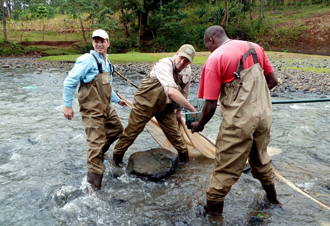Trip to Kenya Nets New Species of Fish
In the rivers of Kenya, new species of fish are waiting to be discovered or at least, to be properly named.

The search for new species of fish takes professor Hank Bart, center, and graduate student Ray Schmidt, left, into a river in Kenya, along with Joseph Gathua of the National Museums of Kenya. (Photo by Taylor Woods)
Hank Bart, professor of ecology and evolutionary biology and a taxonomist, traveled to Kenya with four students from Tulane and Xavier University last summer as part of an International Research Experience for students funded by the National Science Foundation. They collected samples of fish from different river basins, and based on preliminary evidence, the group has identified at least three new species of freshwater fish.
Bart, who also is director and curator of fishes at the Tulane Museum of Natural History, says that a developing country like Kenya is ripe for the discovery of new species because its fauna has not yet extensively or systematically been described or descriptions that do exist are outdated and inaccurate. In some cases, the names given to fish in Kenya go back to the early 1900s, when the methodology for naming fish was not as careful or thorough as it is today.
The first principle of taxonomy, says Bart, is that the first name ever given a species has priority over all others. “You have to look back at old names before you start applying new names,” he says. That's to avoid confusion and make certain that each species has its own unique and accurate name.
Bart and the group have established that the species they identified as new have molecular genetic differences from other species. Now they are in the process of doing morphological studies, looking at the shape and other external characteristics of the fish specimens they've brought back to the lab at Tulane.
The Kenya project will continue for two more summers. Gary Talarchek, senior program manager in the Center for Researchâ“Education Activities at Tulane, is a co-principal investigator on the grant. Representatives from the National Museums of Kenya and the University of Nairobi also are collaborating on the project.
